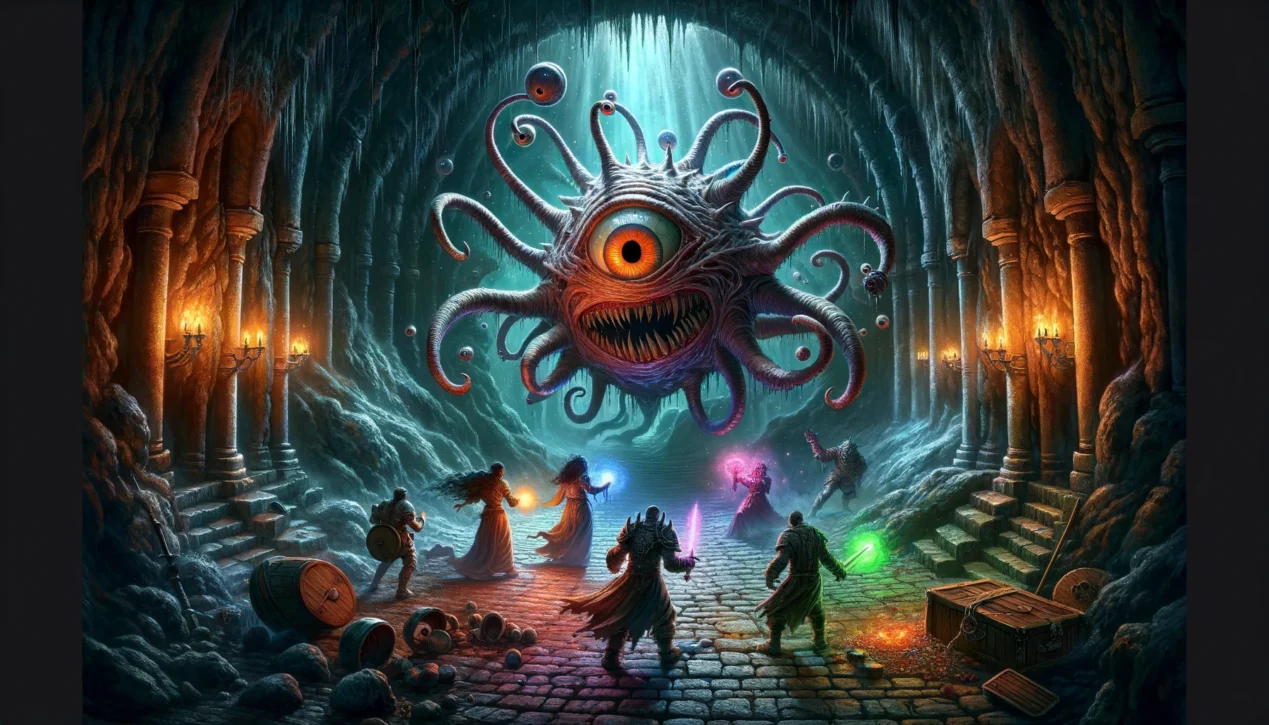In the shadowy depths of a labyrinthine cavern, a group of adventurers stumbled upon a scene straight out of nightmares: a beholder, its central eye fixated on them with a malevolent glare, surrounded by a halo of twitching eyestalks. Beholderen, often referred to simply as beholders, are among the most iconic and feared creatures in the Dungeons & Dragons (D&D) universe. Their grotesque appearance, unsettling aura, and formidable powers make them a formidable foe for any adventurer. This guide aims to provide a comprehensive understanding of beholderen, delving into their origins, anatomy, psychology, and societal dynamics, while also offering practical advice for encountering them in the wild and incorporating them into your own D&D campaigns.
Unveiling the Beholder
Origins and Lore
Beholderen have long haunted the imaginations of adventurers, but their origins trace back to the earliest days of D&D. Introduced in the classic Greyhawk setting, these aberrations have since become a staple of the game’s bestiary. Various creation myths and origin stories surround beholderen, with some claiming they were born from the nightmares of gods, while others believe they are the result of magical experimentation gone awry. Beholderen come in many forms, including death tyrants, beholder zombies, and black horrors, each with its own unique traits and origins that add depth to these already enigmatic creatures. Their relationship with other aberrations, such as mind flayers and illithids, is complex and often hostile, as each vies for dominance in the dark corners of the D&D universe.
Anatomy and Abilities
A beholder’s anatomy is as bizarre as it is deadly. At its center lies a massive eye capable of unleashing powerful magic, while its numerous eyestalks each house a different ray capable of inflicting various horrors upon its enemies. The beholder’s antimagic cone serves as a powerful defense against spellcasters, rendering magic useless within its gaze. In addition to their physical abilities, beholderen possess formidable mental powers, including psionic abilities and a keen intellect that makes them cunning adversaries.
The Beholder’s Mind
Psychology and Motivations
Beholderen are driven by a potent mix of paranoia, megalomania, and insatiable greed, making them unpredictable and dangerous foes. Their solitary nature and tendency towards madness often lead to internal conflicts, though they may form temporary alliances when it suits their interests. This paranoia often manifests in intricate schemes and elaborate traps within their lairs, designed to protect their treasures and thwart intruders. Understanding the psychology of a beholder is key to anticipating their moves and surviving an encounter.
Lairs and Society
A beholder’s lair is a reflection of its twisted mind, filled with traps, treasures, and enslaved minions who serve their master’s every whim. These lairs are often located in remote, hard-to-reach places such as deep caverns, abandoned fortresses, or even within the ruins of ancient civilizations. While beholderen typically prefer to operate alone, they may occasionally form groups, though these alliances are often short-lived and fraught with tension. When multiple beholders do come together, it is usually under extreme circumstances, such as a common threat or the pursuit of a mutually beneficial goal.
Encountering a Beholder
Preparing for Battle
Facing a beholder requires careful planning and strategy. Parties should exploit the creature’s weaknesses, such as its antimagic cone, and consider their composition to maximize their chances of success. Melee fighters can take advantage of the beholder’s focus on magical threats, while spellcasters should be prepared with spells that can bypass or neutralize the antimagic cone. Certain magic items or potions, specifically designed to counter beholderen, can provide a much-needed edge in battle. Items that grant resistance to the beholder’s various rays or provide protection against its mind-affecting abilities are particularly valuable.
Sample Encounters
From a lone beholder guarding its treasure trove to one leading a mindflayer ambush, there are countless ways to encounter these creatures in the wild. Adventurers must adapt their tactics based on the situation, utilizing the terrain and their knowledge of the beholder’s abilities to gain the upper hand. For example, in a confined space, spreading out to avoid being hit by multiple rays at once is crucial. In a more open environment, using cover and line-of-sight blockers can help mitigate the beholder’s ranged attacks. Creativity and adaptability are key to surviving these encounters.
Beyond the Beholder
Beholderen in the D&D World
Beholderen play a significant role in the D&D universe, shaping the world around them through their actions and ambitions. Their influence extends far beyond their lairs, as they scheme and plot to further their own goals, often at the expense of others. Beholders are known to manipulate other creatures and even entire societies to serve their ends, using their formidable intellect and psionic abilities to bend others to their will. Their machinations can have far-reaching consequences, affecting the political and social landscapes of the regions they inhabit.
Adapting Beholderen for Your Campaign
For Dungeon Masters looking to incorporate beholderen into their campaigns, the possibilities are endless. By tweaking their abilities or creating unique encounters and storylines, DMs can challenge their players in new and exciting ways, ensuring that the legacy of beholderen lives on in the hearts and minds of adventurers everywhere. Customizing a beholder’s lair to reflect its specific obsessions and paranoia can add depth and complexity to the encounter. Additionally, integrating beholders into larger story arcs, such as an overarching villain or a key player in a grand conspiracy, can make for memorable and impactful adventures.
Conclusion
In conclusion, beholderen stand as one of the most iconic and fearsome creatures in the D&D universe, captivating players and Dungeon Masters alike with their otherworldly appearance and formidable powers. As you embark on your own adventures, remember to tread carefully in the presence of these enigmatic beings, for to underestimate a beholder is to invite certain doom. Whether you are a player preparing to face one in battle or a DM looking to incorporate one into your campaign, understanding the intricacies of beholderen can enhance your D&D experience. So, go forth, brave adventurers, and may your encounters with beholderen be both thrilling and memorable.
FAQs About Beholderen
1. What is a beholder in D&D? Beholders are iconic, eye-stalked aberrations feared by adventurers for their deadly powers and formidable intellect.
2. How do you defeat a beholder? Defeating a beholder requires exploiting its weaknesses, such as its antimagic cone, and careful strategic planning. Utilize the terrain, coordinate attacks, and employ magic items that counter its abilities.
3. Are there different types of beholders? Yes, there are several types of beholders, including death tyrants, beholder zombies, and black horrors, each with unique traits and abilities.
4. Do beholders work with other creatures? While beholders are mostly solitary, they may form temporary alliances with other creatures if it serves their interests. However, these alliances are often fraught with tension and conflict.
5. How do beholders impact D&D campaigns? Beholders can significantly shape D&D campaigns through their actions and schemes. They can serve as formidable foes, influential NPCs, or key players in larger story arcs, creating challenges and driving the narrative forward.
By understanding the lore, abilities, and psychology of beholderen, adventurers and Dungeon Masters can create rich, engaging, and challenging encounters that bring the world of Dungeons & Dragons to life. Whether facing a beholder in battle or weaving its intricate plots into a campaign, these iconic creatures continue to be a source of fascination and excitement in the D&D universe.






